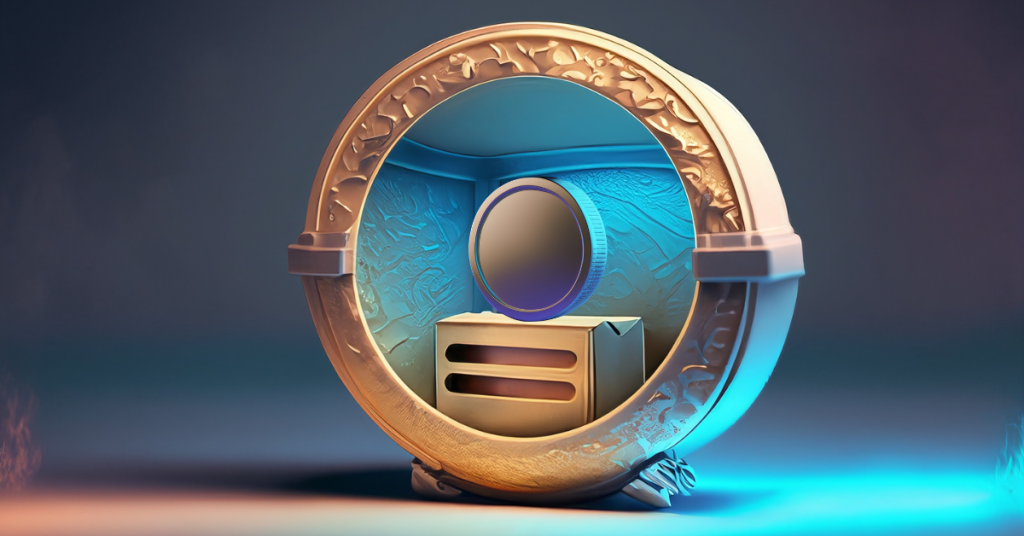The post Unveiling Wrapped and Pegged Tokens: A Beginner’s Guide to the Basics appeared first on Coinpedia Fintech News
As we study the evolution in the cryptocurrency realm, we often come across new tokens and technologies being added. Wrapped and pegged tokens are a crucial part of today’s crypto world. As the name suggests, “wrapped” tokens are the ones belonging to a blockchain which are wrapped or converted to another token on another blockchain! Whereas, pegged tokens are the ones whose values are “pegged” to the value of another existing asset. Their major utility lies in creating stablecoins to maintain a steady value and lessen the effect of volatility in cryptocurrency.
| KEY TAKEAWAYS
Wrapped tokens address the issues of interoperability, cross-chain transactions and wider acceptance of the DeFi system.Pegged tokens ensure price stability in the highly volatile crypto market.Wrapped BTC is the 23rd largest cryptocurrency in the crypto sphere.In the latest news, Tether lost 1:1 to USD amid heightened sell pressure in Curve’s 3Pool. Read here to know more about USDC Vs. USDT ongoing updates. |
1.1. The story of token evolution
The story of token evolution is quite fascinating! The concept of digital currency started with the advent of Bitcoin. With the continuous upgradation in technology, the need for wrapped and pegged tokens was seen.
Wrapped tokens came into existence in order to bring assets from one blockchain to another without any hassle. Initially, most of the decentralized projects worked on the Ethereum blockchain which created a mess in working with tokens like Bitcoin (having its own blockchain). Wrapped tokens allow one token holder to work seamlessly with another token ecosystem. Hence, the new token system was born!
On the other hand, pegged tokens were created to handle the major issue in the cryptocurrency world, that is, price volatility! Due to severe fluctuations in value, stable transactions were not easy. Therefore, stablecoins were introduced. These coins are pegged or fixed at a value of relatively stable assets like the US Dollar.
Both, wrapped and pegged tokens form the foundation of crypto innovation and add to the versatility quotient of the cryptocurrencies.
1.2. What are interoperability and stability in tokens?
The two terms, interoperability and stability, make the base of the wrapped and pegged tokens. Let us understand how!
- Interoperability is the ability of different blockchains and related tokens to work with each other without any obstacle. We know that blockchain networks have their own protocols and regulations. However, if we wish to tap the most out of this technology, blockchains shall not limit to their own ecosystems by allowing them to work with other networks too. Interoperable tokens make this situation possible! They can “operate” with varied blockchains. It is very vital for adopting blockchain technology for a wider and more efficient use. Therefore, “interoperability” is a key role player in deriving the most out of the vast blockchain ecosystems.
- Stability refers to the value of the tokens. Known for the extremely volatile space, the cryptocurrency world was in dire need of stable tokens which could maintain a constant value over a period of time. Stablecoins have majorly helped in this sector! They are pegged to stable assets’ values to minimize price volatility.
This is why interoperability and stability are salient features of the new crypto world!
1. What are Wrapped tokens?
We would like to take you through an example here! Suppose you have a box which can only hold specific coloured balls, that is, black. This box is like a blockchain which can only handle a specific kind of token such as an Ethereum-based token. You wish to put white coloured balls in the box but it cannot hold it due to its specification. Then, you need to wrap the balls with black paper in order to fit in! This wrapped ball is like a wrapped token. It represents the original white ball transformed into black to get inside the box. Similarly, tokens are wrapped to serve the purpose of fitting into different blockchain networks.
Wrapped tokens allow you to use different tokens with different blockchains. You can use wrapped Bitcoin in the Ethereum blockchain by wrapping the original Bitcoin with an Ethereum-compatible version. You can always unwrap the ball, or the token to get back the original entity. This wrapping and unwrapping process helps in working across different blockchains.
2.1. Why are Wrapped Tokens used?
The overall usage of wrapped tokens could be summed up in the following points:
- Interoperability: To enable operations across different blockchain networks.
- Liquidity: To enable users access more trading pairs and lending options, thus increasing liquidity in DEXs.
- DeFi: To allow lending,borrowing, yield farming easily in the DeFi system.
- Compatibility: To make the tokens compatible with different sorts of ecosystems and blockchain networks.
2.2. Are they safe?
There are certain risk factors associated with wrapped tokens:
- Wrapped tokens built on smart contracts can be accessible to bugs or vulnerabilities in the code. A poorly audited smart contract could lead to a loss of funds.
- Wrapped tokens which are not compliant with regulations could face severe challenges!
- Using these tokens involves depending on third parties like custodians in order to provide the backing assets and promote token swaps. This could bring in the element of trust and dependency!
These risks could be mitigated if users perform diligent research and exercise caution before using the wrapped tokens.
2. Pegged Tokens and their functionality
We all have been to food courts offering tokens in exchange for real money. Suppose we wish to eat at a food court and buy tokens which are pegged to the value of $1 each. We can exchange $10 for 10 tokens, with these tokens we can eat our meals. After buying what we needed, we were left with 2 tokens. Now, we can easily exchange these 2 tokens back for $2 USD because each token was pegged at $1.
Hence, the tokens are stabilised at the value of $1 USD each. Such is the role of pegged tokens in the crypto world.
2.1. Definition: What is pegging?
The act of tying the value of one asset to the value of another asset is called pegging. Pegged tokens are devised to maintain stability by pegging the tokens to the value of another asset.
2.2. Purpose
The strong purposes of pegged tokens could be:
- Stability : To ensure that there is trust in the value of tokens and it won’t change with the market fluctuations!
- Reduced Volatility: To avoid the rapid fluctuations in the cryptocurrency world , pegged tokens are used to prevent breakdowns.
- User-friendly nature: to make sure that the usage is easier for people to get accustomed to the crypto world as the token value remains familiar and constant.
- Hedging: To be used as a “hedge” against the volatility of other currencies. During times of uncertainty, traders often move the funds to pegged tokens.
2.3. Types of Pegged Tokens
- Fiat-collateralized: Tokens which are backed by traditional fiat currency reserves like the USD. Eg: USDT
- Crypto-collateralized: Pegged tokens backed by other cryptocurrencies where a certain amount of currency is locked up as collateral. Eg: DAI
- Commodity-collateralized: Tokens backed by physical assets like precious metals or commodities.
2.4. Benefits of Pegged Tokens
Pegged tokens bring stability, reliability and versatility to the crypto world:
- Price stability is there due to a constant value allotted to the asset.
- Reduced volatility as extreme price fluctuations could be avoided
- Cross-border transactions provide a reliable channel for conducting cross-border transfers.
- Pegged tokens can make crypto easy for people who are hesitant to participate due to extreme price volatility.
- These are globally accessible to all!
3. Wrapped Tokens in the Real world
The tokens exist in the real world as they provide compatibility among different blockchains!
3.1. WBTC Vs. WETH
- WBTC or Wrapped Bitcoin represents Bitcoin built on the Ethereum blockchain. It brings the value of BTC into the ETH ecosystem. WBTC allows BTC holders to use their tokens in the Ethereum network easily. It is backed 1:1 by actual BTC held in reserve by the custodians.
- WETH or Wrapped Ethereum represents Ether (ETH) and it operates within the Ethereum blockchain itself,creating standardized ERC-20 tokens. They work towards making Ether more versatile and tradable on DEXs. It is not backed by external assets like BTC, instead it has an equivalent amount of Ether in reserve on the Ethereum blockchain!
4. Pegged Tokens and their real-world applications
The real-world applications tell us how pegged tokens address challenges related to volatility in cryptocurrencies:
- International Trade is facilitated through pegged tokens as businesses transact without any risk of currency fluctuations and uncertainties.
- Microfinance loans and transactions are greatly served in regions with unstable local currencies through pegged tokens.
- Central Bank Digital Currencies (CBDCs) are launched by some banks while exploring the idea of pegged tokens as the digital face of their national currencies. Thus, providing the benefits of cryptocurrencies and maintaining the stability of traditional ones. Tether (USDT) is a pegged token pegged to the USD, aiming to maintain a 1:1 ratio.
5. Emerging Trends in Wrapped and Pegged Tokens
The wrapped and pegged tokens have made some progress in the past few years, enabling trends like:
- Increased DeFi adoption due to the demand for stable and cross-chain compatible assets.
- Cross-chain solutions have been possible due to these tokens! They enable seamless movement of assets across a variety of blockchains.
- Facilitating DEXs and their functionality due to the greater adaptation to different ecosystems.
- As the usage of these tokens increases, regulations in the crypto landscape have also been considered necessary. This is highly important for the safety of investors and businesses.
6. Final thoughts
Wrapped and Pegged tokens contribute to the broader adaptation of blockchain technology by providing solutions to the older ways of crypto trading. They have efficiently addressed the issues related to interoperability, stability and accessibility across different sets of blockchains. The way the crypto circle is getting bigger, it is believed that innovations could make it more aligned and profitable. These two tokens are one of the best elements of the crypto evolution story!
7. FAQs
They are safe when used with the right information and backed by the renowned custodians or secure smart contracts. Good research is the key!
Wrapped Bitcoin (WBTC) is the one representing Bitcoin on Ethereum blockchain!
Tether (USDT) is a pegged token pegged to the USD, aiming to maintain a 1:1 ratio.


